|
#1. TRIPLE SUGAR IRON (TSI) AGAR
Triple sugar iron (TSI) agar is a medium used in the identification of
Gram-negative enteric rods. The medium measures a bacterium's ability to utilize
three sugars, glucose, sucrose and lactose, the concentrations of which are
0.1%, 1.0%, and 1.0%, respectively. A pH indicator incuded in the medium can
detect acid production from fermentation of these carbohydrates. A yellow color
change indicates acid in the medium while no color change indicates an alkaline
surrounding. Inoculation of the tube is a two step procedure. First, a loop of
bacteria is spread across the surface of the agar. Second, a needle of bacteria
is inserted (stabbed) into the bottom (butt) of the tube. Carbohydrate
uilization can be determined through analysis of the extent of acid production.
Acid production limited to only the butt of the tube is indicative of glucose
utilization. This is because the concentration of glucose is lower than that of
other sugars, thus the acid production is not very extensive. Acid production in
the slant and butt indicates sucrose or lactose fermentation because of the
relatively high concentrations of these sugars, thus leading to extensive acid
production. TSI agar can also detect reduction of sodium thiosulfate to hydrogen
sulfide. Hydrogen sulfide production will turn parts of the agar black.
Production of other gases is marked by cracks in the agar as well as an air gap
at the bottom of the test tube.

| INTERPRETATION OF TUBES ABOVE |
|
TUBE 1
(UNINOCULATED) |
TUBE 2 |
TUBE 3 |
TUBE 4 |
TUBE 5 |
| SLANT |
- |
A |
A |
K |
K |
| BUTT |
- |
A |
A |
A |
A |
HYDROGEN
SULFIDE |
- |
- |
- |
+ |
+ |
| GAS |
- |
- |
+ |
- |
- |
| A=Acidic K=Alkaline |
#2. TRYPTIC SOY BROTH/AGAR
Tryptic soy agar and broth is a basic medium used for culturing many kinds of
microorganisms. Tryptic soy agar is mainly used as an initial growth medium for
the following purposes:
- observe colony morphology
- develop a pure culture
- achieve sufficient growth for further biochemical testing
- culture storage
Tryptic soy broth is used mostly to generate a
large supply of bacteria for certain bichemical tests. It can also be used in
the determination of bacterial numbers.
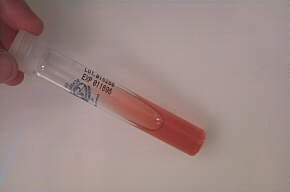
#3. CHOCOLATE AGAR
Chocolate agar is a nutrient medium which is used in culturing fastidious
organisms such as Haemophilus species and Neisseria. It is
comprised of sheep blood that provides the X and V factors necessary for
Haemophilus growth. Chocolate agar, however, does not reveal hemolysis
data, so species differentiation among the members of Haemophilus must be
performed in another manner.
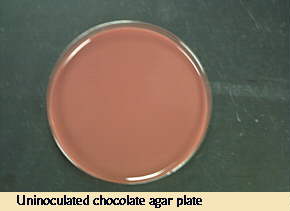
#4. CHOPPED MEAT GLUCOSE MEDIUM
Chopped meat broth is used for culturing anaerobic organisms.
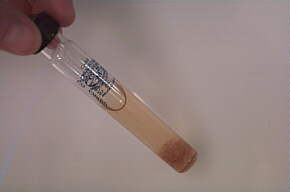
#5. EOSIN METHYLENE BLUE (EMB) AGAR
EMB agar is a differential medium used in identification and isolation of
Gram-negative enteric rods. EMB agar also inhibits the growth of Gram-positive
organisms. The differential basis of this medium involves two indicator dyes,
eosin and methylene blue, that distinguish between lactose fermenting and
non-lactose fermenting organisms. Lactose fermenters form colonies with dark
centers and clear borders while the non-lactose fermenters form completely
coloroless colonies.
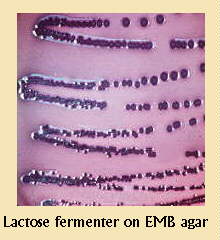
#6. MANNITOL SALTS AGAR
A common medium used for the isolation of pathogenic staphylococci is the
Mannitol Salts Agar. The high salt concentration of this medium inhibits the
growth of most other organisms. Pathogenic staphylococci not only grow on the
medium, but they also produce acid from it. This acid production turns the pH
indicator from red to yellow. Non-pathogenic staphylococci can grow on the
medium but produce no acid from it.
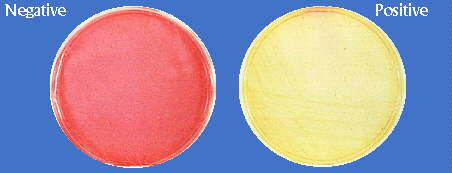
#7. MACCONKEY AGAR
MacConkey agar is probably the most popular solid differential medium in the
world. It is mainly used in identification of lactose fermenting, Gram-negative
enteric pathogens and for inhibiting growth of Gram-positive organisms.
Bacterial colonies that can ferment lactose turn the medium red. This red color
is due to the pH indicators response to the acidic environment created by
fermenting lactose. Organisms that do not ferment lactose do not cause a color
change.
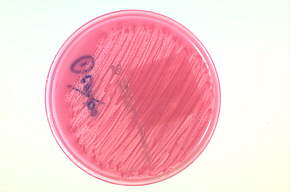
#8. HEKTOEN ENTERIC(HE) AGAR
Hektoen enteric agar is a medium designed for the isolation and recovery of
fecal specimens belonging to the Enterbacteriaceae family, especially
Salmonella and Shigella. It can differentiate between bacteria
that ferment lactose and those that don't. Acid produced from fermenting lactose
imparts a yellow-orange color to the medium due to the presence of a pH
indicator. Non-lactose fermenters do not significantly change the color of the
medium. HE agar can also detect the production of hydrogen sulfide gas, which
turns parts of the medium black.
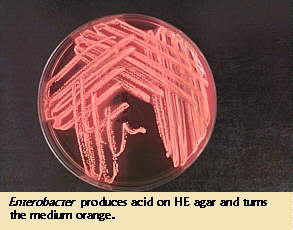

|
